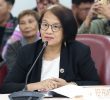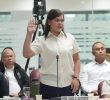Second of Three Parts
By Floreen Simon and Malou Mangahas

IN THE May 2019 elections, not just two but all three children of President Rodrigo R. Duterte by estranged spouse Elizabeth A. Zimmerman are running. But unlike those of many other candidates, their clan coffers won’t be running empty. In fact, these are probably going to end up largely untouched, or may even be further enhanced wealth-wise, as in previous campaigns
In large part, that is thanks to a family brand name that has instant recall for most Filipinos nowadays. Indeed, the three adult Duterte children only need to remind people what they are gunning for: another term as mayor for Sara; as 1st District Representative of Davao City for the eldest, Paolo; and as vice mayor of Davao City for the youngest, Sebastian.
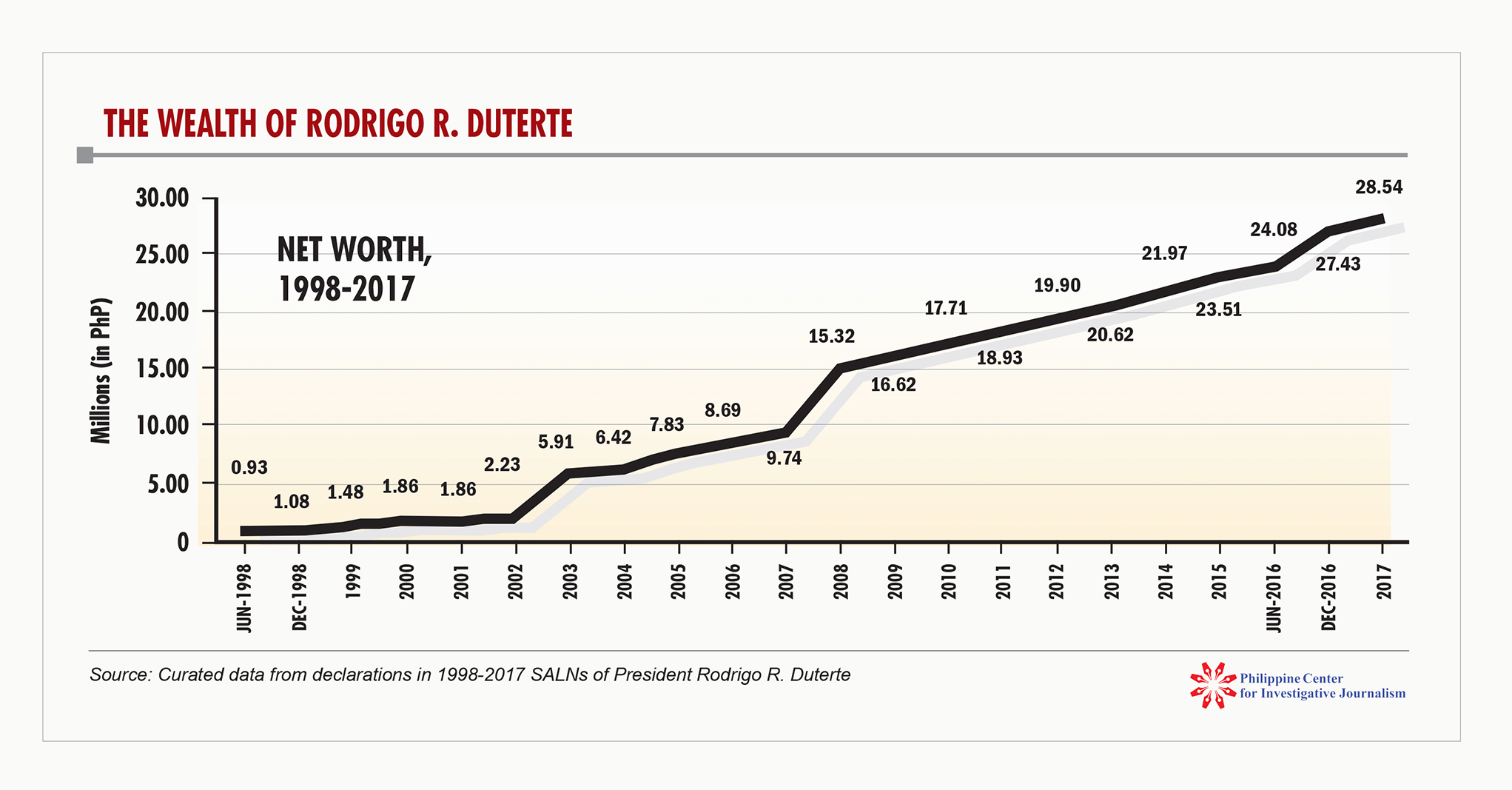
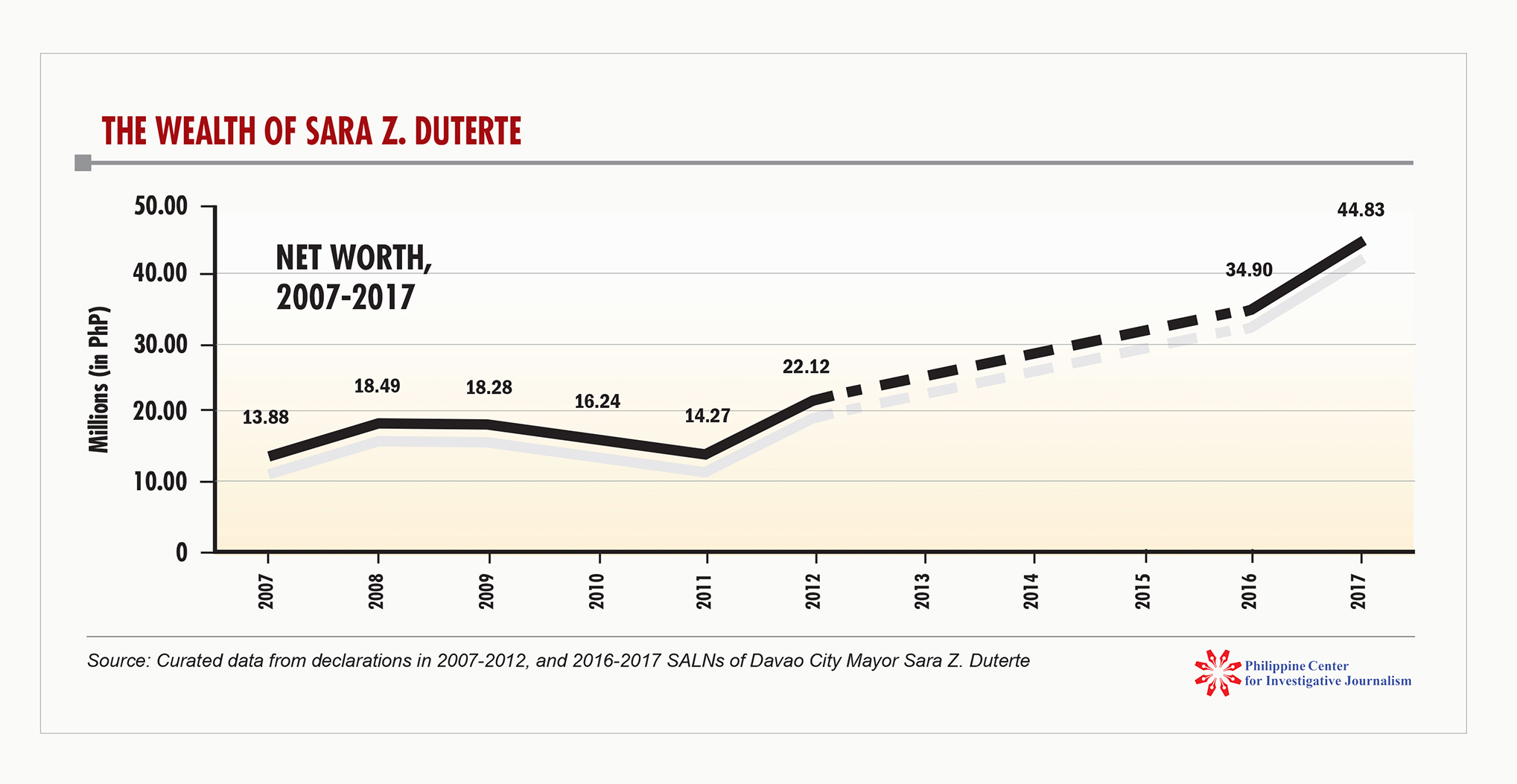
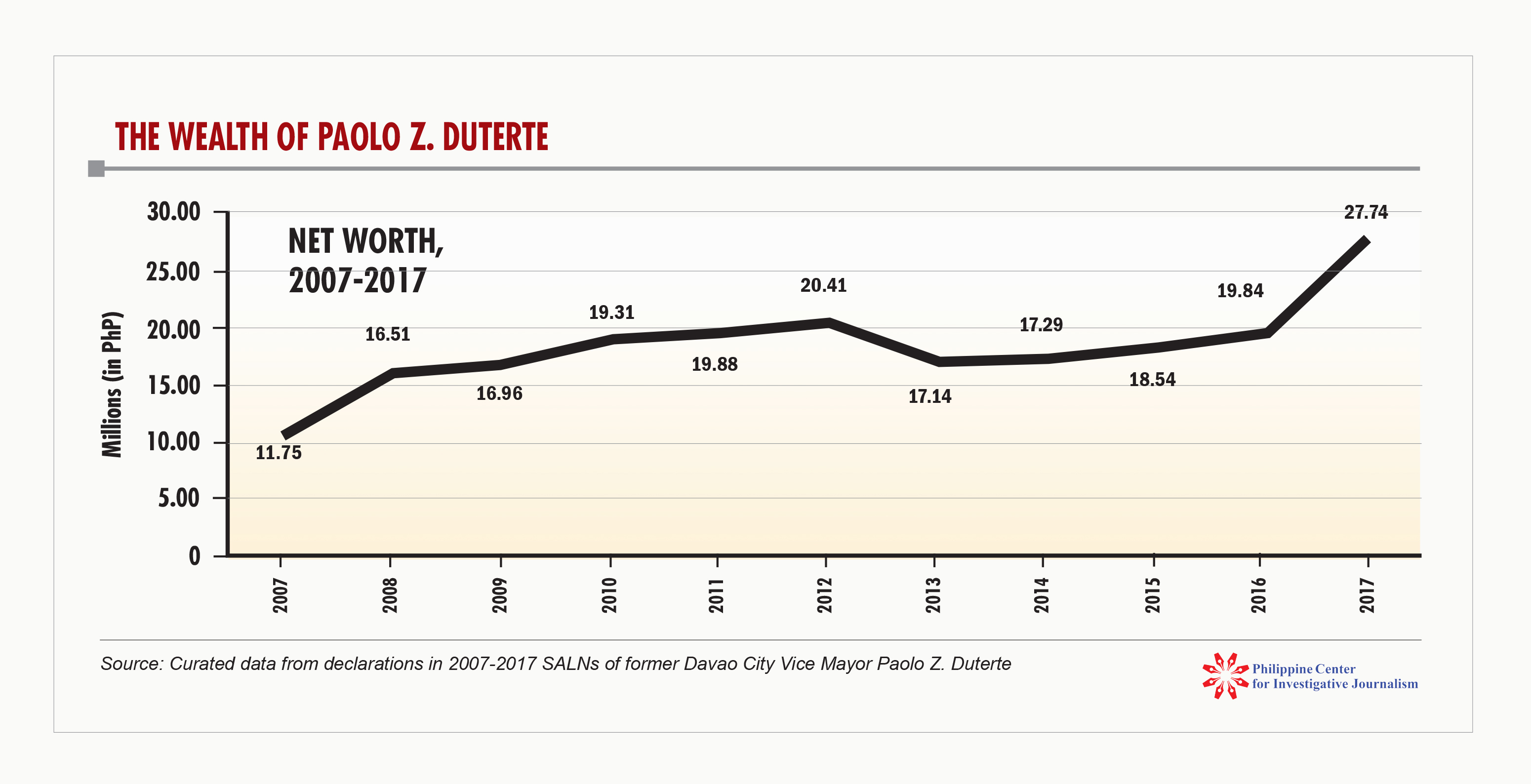
Their father also isn’t poor, although he has said on several occasions that he was raised in a poor family. When allegations rose two years ago about his supposedly having questionable bank transactions that ran into multimillions of pesos, the President had shot back that his family had really done quite well.
To be more exact, in a speech in February 2017, Duterte addressed his nemesis, Senator Antonio Trillanes IV, who was calling for a probe into the transactions. Said the President: “Hindi kami kasing malas sa pamilya mo. Hindi kami mahirap. Tatay ko, governor noon, may iniwan sa akin.(We are not as unfortunate as your family. We are not poor. My father who used to be governor left me inheritance.)”
So if he isn’t poor, then how rich is Duterte? And Sara? And Paolo?
The President has yet to go into detail about his questioned bank accounts, at least in public. In theory, however, citizens can find that out for themselves by looking at the SALNs that the Dutertes had filed during their extended years in public office.
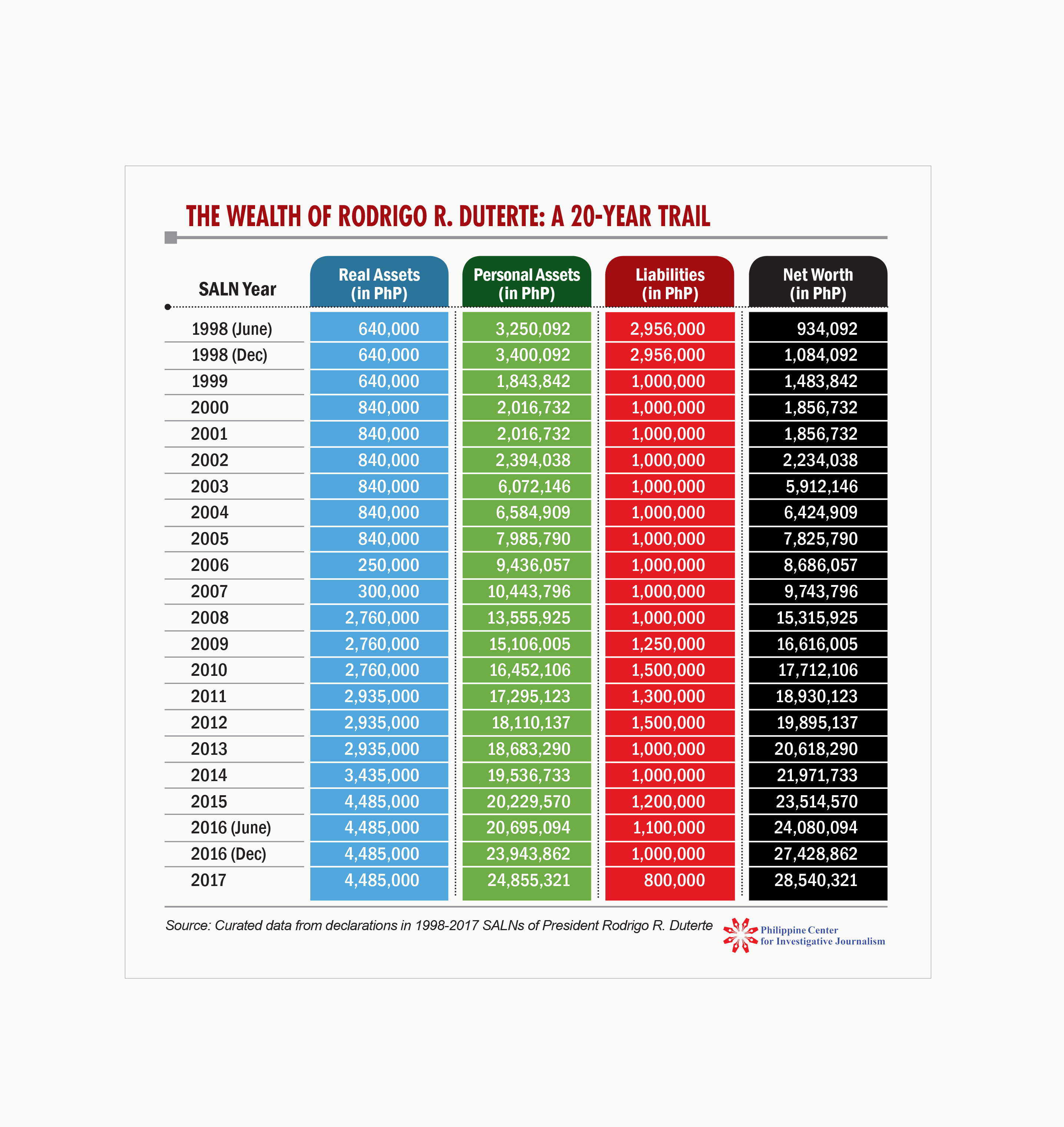
A bundle of SALNs
PCIJ did just that, and looked at 22 SALNs that Duterte had filed since 1998; 11 filed by Paolo since 2007; and eight filed by Sara since 2007. PCIJ also checked with the Securities and Exchange Commission (SEC) records on the business interests and financial connections listed and not listed in their SALNs, and with relevant sources, the background of their major business associates, debtors, and relatives in government.
Not surprisingly, father, son, and daughter, now all have a net worth in eight digits each; Sara seems to be the wealthiest among the three as of their 2017 SALNs, Duterte a far second, and Paolo, a close third.
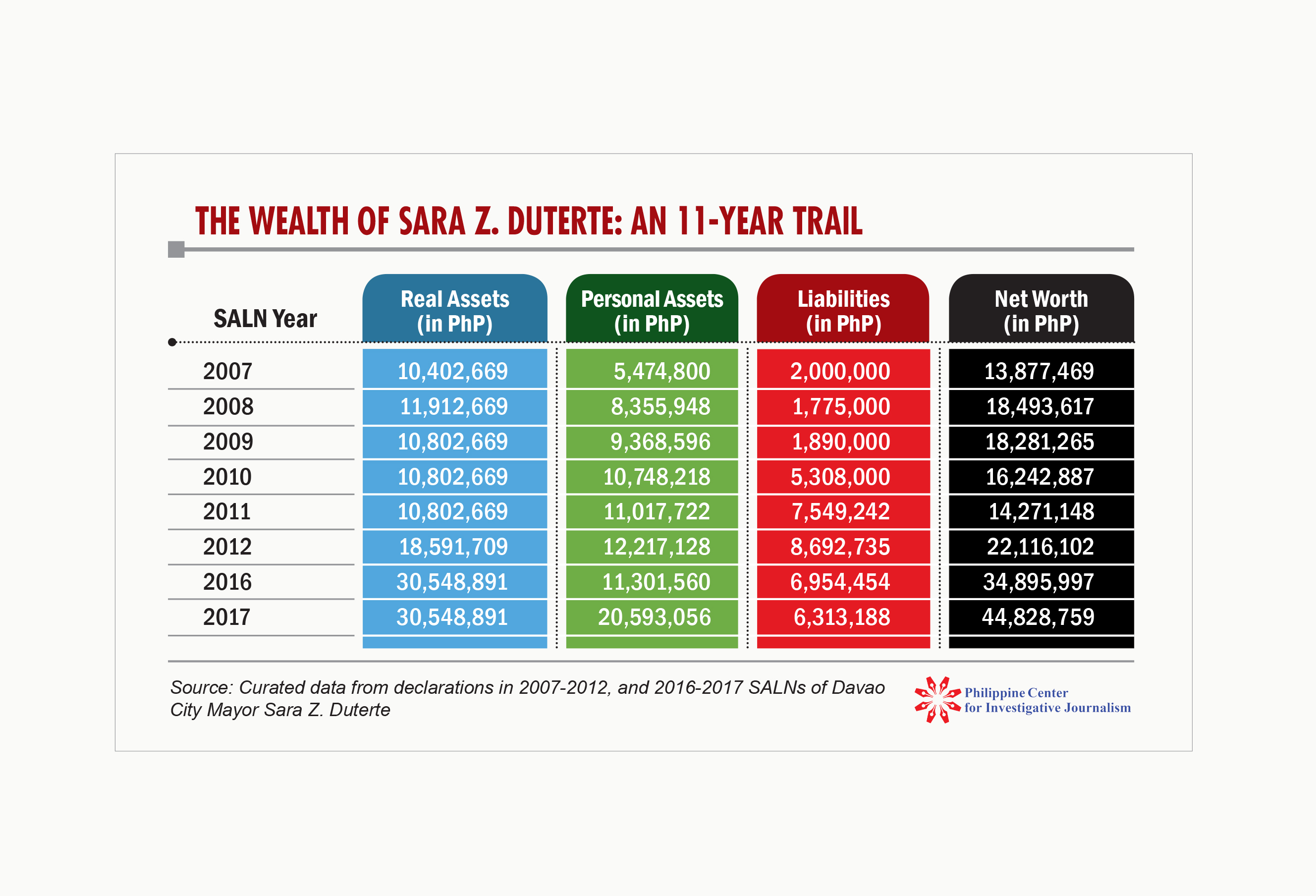
Still, the President, Sara, and Paolo have all consistently grown richer over the years, even on the modest salaries they have received for various public posts, and despite the negligible retained earnings reflected in the financial statements of the companies they own or co-own. How and why their fortunes are rising remain a mystery; the numbers do not seem to add up, and what they reveal in their SALNs breed riddles of incongruent details instead of clarifying questions.

Numbers in a jumble
In truth, filling out the SALN form by the rules appeared to be a challenge at times for all three, even though the President and Sara are both lawyers and Paolo has a “PhD in Public Administration” courtesy of short courses offered by the Philippine Councilors League Legislative Academy. In earlier SALNs, for example, all three pegged their net worth on the fair market values of their real assets, instead of on their acquisition costs, as the rules require.
Too, the SALNs offer little or no clues for some curious instances, such as where excess campaign funds went in the case of the President in 2016, or a sudden spike in the cash assets of Paolo, or his acquisition of real estate properties with no clear source of funding.
Republic Act No. 6713 or the Code of Conduct and Ethical Standards for Public Officials and Employees was enacted on February 20, 1989. The law states that “Public officials and employees have an obligation to accomplish and submit declarations under oath of, and the public has the right to know, their assets, liabilities, net worth and financial and business interests including those of their spouses and of unmarried children under eighteen (18) years of age living in their households.” It also stipulates that SALNs be within 30 days after assumption of office; on or before April 30, of every year thereafter; and within 30 days after separation from the service.
The Implementing Rules and Regulations or IRR of R.A. No. 6713 was approved on April 21, 1989, which set the effectivity of the law 30 days thereafter or specifically, May 21, 1989. In compliance with the law, public officials began filing SALNs in 1990 declaring their assets, liabilities, and net worth for year 1989. There was some observed confusion, however, as to where SALNs should be submitted, necessitating the Civil Service Commission (CSC) to issue Memorandum Circular No. 9, series of 1991, to clear up the matter.
Millionaire kids
The earliest SALN of President Duterte that PCIJ was able to obtain was the one he filed in 1998, when he was the representative of Davao’s 1st District. At the time, he declared having a net worth of PhP898,000. By then he had already spent a decade as mayor of Davao City. PCIJ could not ascertain as of press time if he had filed earlier SALNs.
Sara filed her first SALN in 2007, when she was elected vice mayor of Davao City, her debut year in public office. She declared her net worth at the time as being PhP7.25 million. Paolo filed his first SALN also in 2007, after being elected Barangay Captain of Catalunan Grande, Davao City. He declared a net worth of PhP8.34 million
Rodrigo Duterte should have been filing his 11thSALN by then. But there is something unusual, even inscrutable, about the SALNs that the three Dutertes filed in the year 2007.

Born on May 31, 1978, Sara Z. Duterte was then just 29 years old. She had passed the bar only a year earlier and was later briefly employed as a court attorney with a Supreme Court associate justice. In her 2007 SALN, Sara declared PhP3.77 million in real assets (by fair market value), PhP5.47 million in personal assets, and liabilities of PhP2 million. She also said that she was a stockholder in three entities engaged in “miscellaneous service activities” (restaurants, coffee shops) and wholesale trade. Two of these three were established and registered also in 2007.
Paolo earned a commerce degree from the University of Mindanao in 2002, a master’s degree in public administration from the University of Southeastern Philippines in 2009, and a PhD in public administration from the Philippine Councilors League-Legislative Academy and the Lyceum-Northwestern University in 2015. Documents show that before he became an elected official, he had at least one business venture, Server Cuisine, which was registered with the SEC in November 2006. He declared three more firms engaged in “hotels and restaurants” and real estate as part of his business portfolio in his 2007 SALN.

Born on March 28, 1945, Rodrigo R. Duterte was already 62 years old in 2007 and in his 21st year as a public official, after nine years of labor as a prosecutor and trial lawyer. He was appointed vice mayor in 1986, and then was elected mayor for several terms beginning 1998. In his 2007 SALN, Duterte declared a net worth of only PhP9.69 million. It consisted of PhP241,570 in real assets (combined fair market value and improvements), PhP10.44 million in personal assets, and liabilities of PhP1 million. The latter is the same absolute amount of his liabilities from 1999, when he filed what should have been his third SALN.
Among the three, Duterte had obviously worked the longest by 2007. But if their net worths were recalculated using the acquisition cost instead of fair market value for their real-estate holdings, he would emerge as the least wealthy.
CSC requirement
One thing that the three Dutertes’ earlier SALNs have in common is the absence of the acquisition cost of their real properties. According to R.A. No. 6713, a properly accomplished SALN form should indicate the public official’s real property, its improvements, acquisition costs, assessed value, and current fair market value. A 2011 CSC memorandum circular also says that “for computation purposes of real properties, acquisition cost shall be used.”
The acquisition cost of a real or personal property is the amount by which the property was acquired. Unlike assessed and current fair market value, the acquisition cost of a property does not change over time unless improvements are undertaken, in the case of real properties. Leaving it out in the SALN thus provides no means to compute a public official’s net worth unless the amount is reported in previous or succeeding SALN submissions.
The President, Sara, and Paolo, however, later provided in their 2008 SALNs the acquisition costs of their real properties that were missing in their earlier SALNs.
Using these figures, PCIJ recalculated their net worth for their earliest SALNs that the Center was able to obtain. Paolo Duterte’s net worth in 2007 thus climbed to PhP11.7 million, Mayor Sara’s to PhP13.9 million, and the President’s (in 1998) to PhP934,000. For 2007, the President’s recalculated net worth came up to PhP9.74 million.
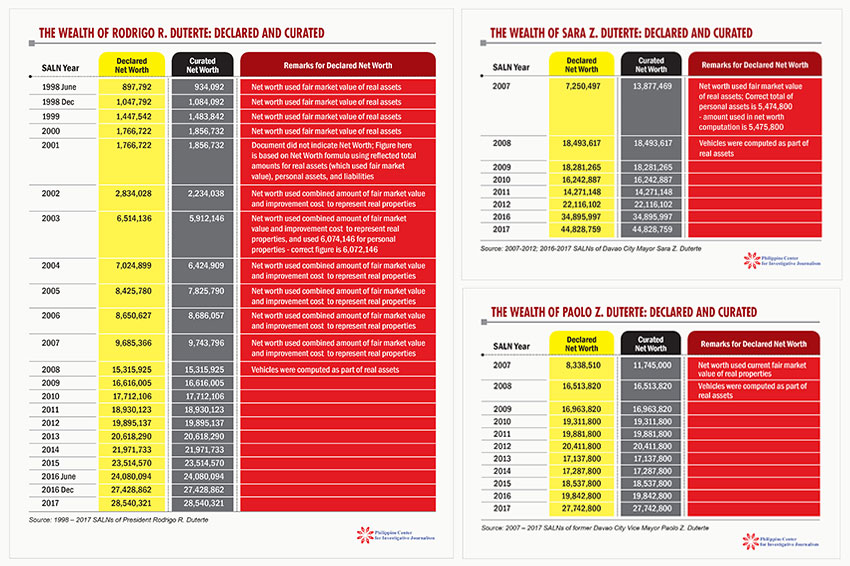
Inherited assets?
If he were only less destitute than his children, it would seem possible that their relative affluence had been boosted by inherited cash and assets. But he was the most soaked in penury at the time.
Then again, the SALNs that Duterte filed in 2005 and 2006 offer some data about real assets that he said he had passed down to his three children by Elizabeth Zimmerman.
In 2005, Duterte had listed owning one inherited and two purchased farm land, all in Binugao, Davao City; an inherited lot in Dumoy, Davao City; three purchased residential lots (in Bangkal, Bago, and Ma-a in Davao City), and a residential house and lot in Catalunan Grande, Davao City. He said that the fair market value and improvement costs of the eight real properties he purchased and two properties he inherited amounted to PhP1.44 million.
But by his 2006 SALN, Duterte listed only two residential lots – in Bago Aplaya and Ma-a – as his own properties. He made this declaration: “Note: All other lots previously declared were already transferred to the three (3) children and to Elizabeth Zimmerman on May 24, 2006.”
That meant that Duterte had transferred six of his real assets to Zimmerman, Paolo, Sara, and Sebastian, but his 2006 SALN did not specify who got which property.
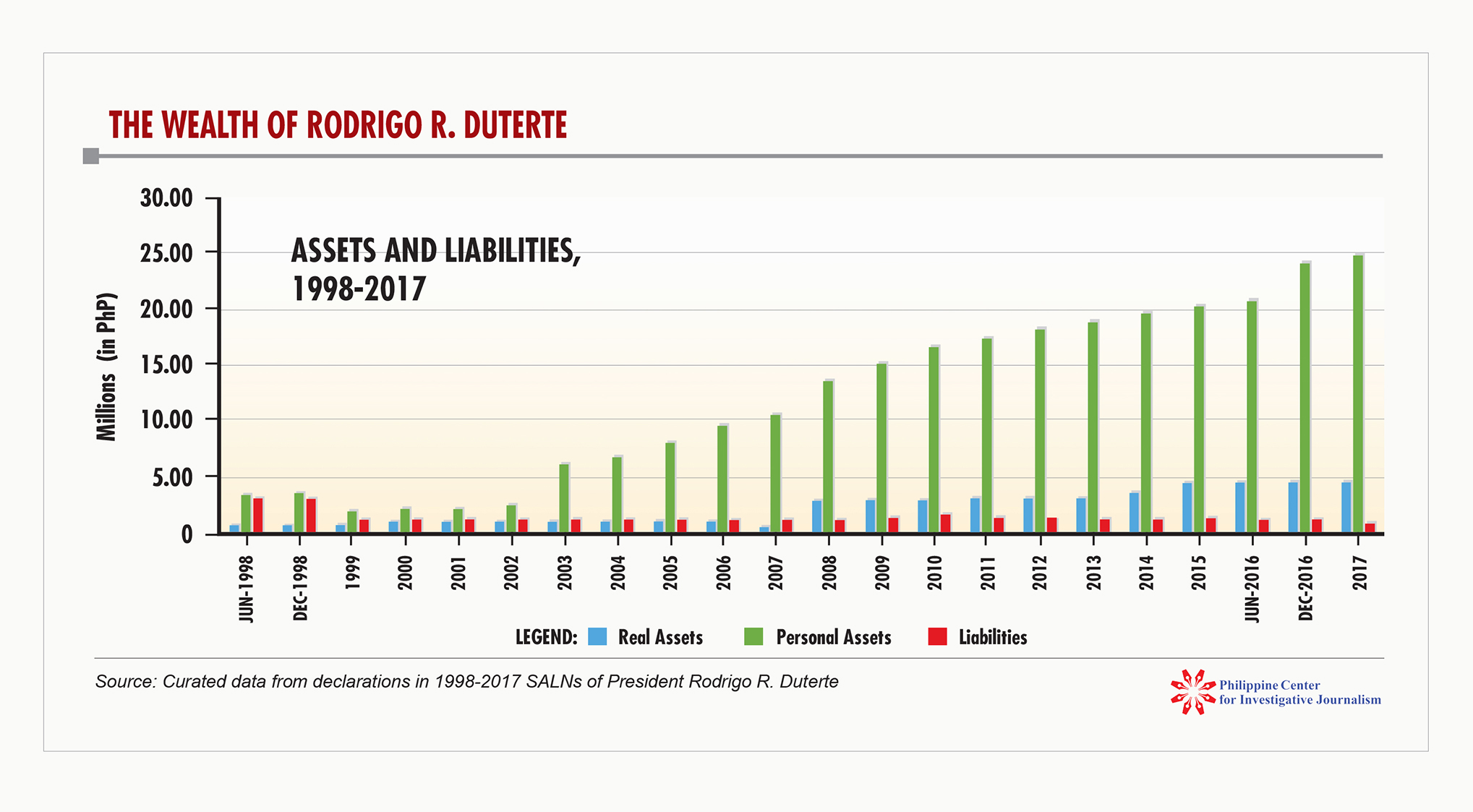
One possible connecting data showed up in Paolo’s 2007 SALN where he declared three properties as “donations,” including one in Catalunan Grande with a fair market value of PhP146,290. This is the same amount that Duterte’s 2005 SALN enrolled for the same property. The only difference is Paolo’s 2007 SALN says that this property is a “land and building,” in contrast to Duterte’s 2005 SALN, which calls it just a “residential house & lot.”
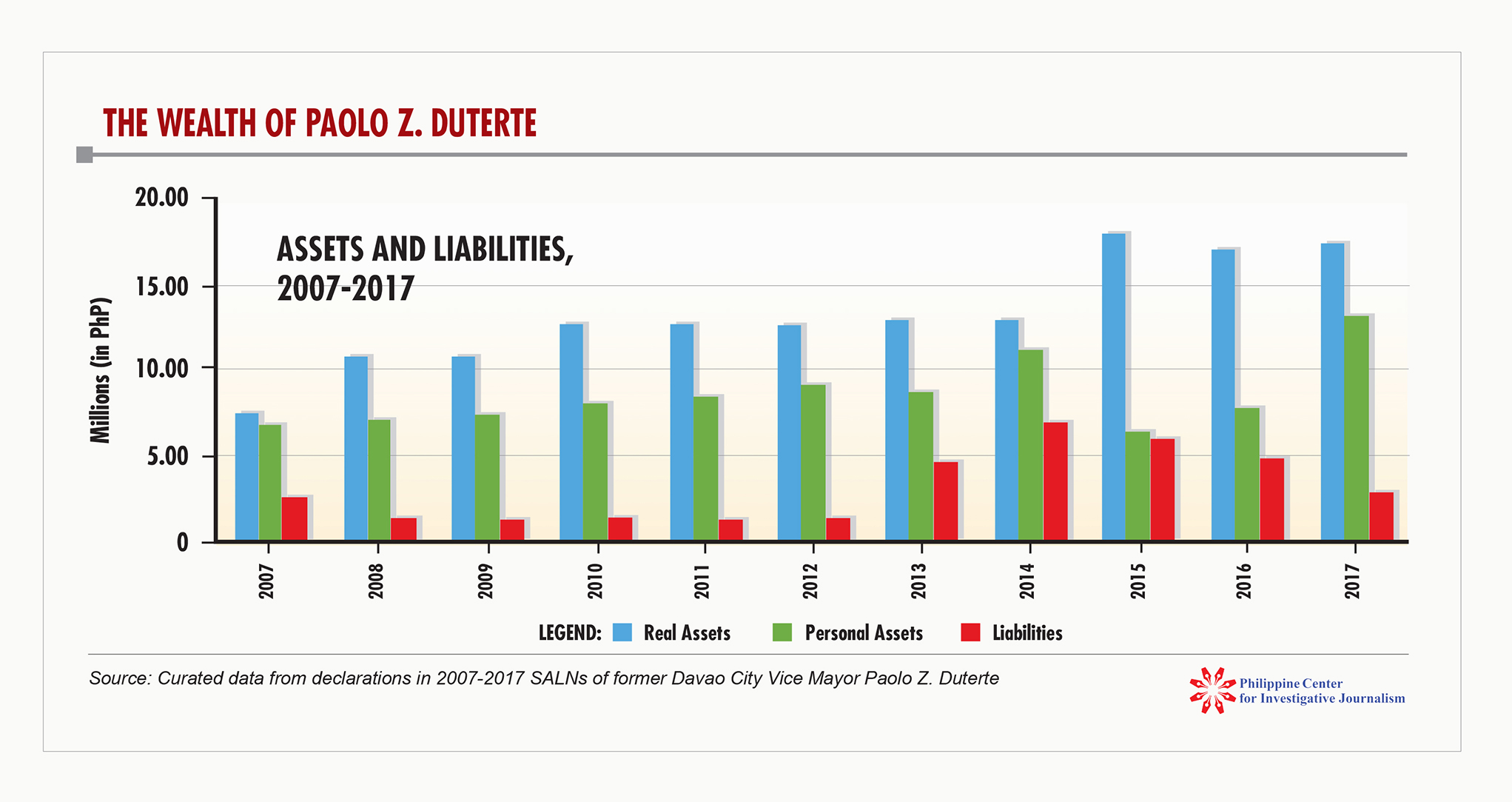
Sara’s 2007 SALN, meanwhile, listed six real properties (one land and building and four parcels of “lands” in Ecoland, Buhangin, Binugao, and Catigan, all in Davao City; and a condo unit in Quezon City) that were all “purchased.” Sara did not declare any inherited or donated property in her 2007 SALN.
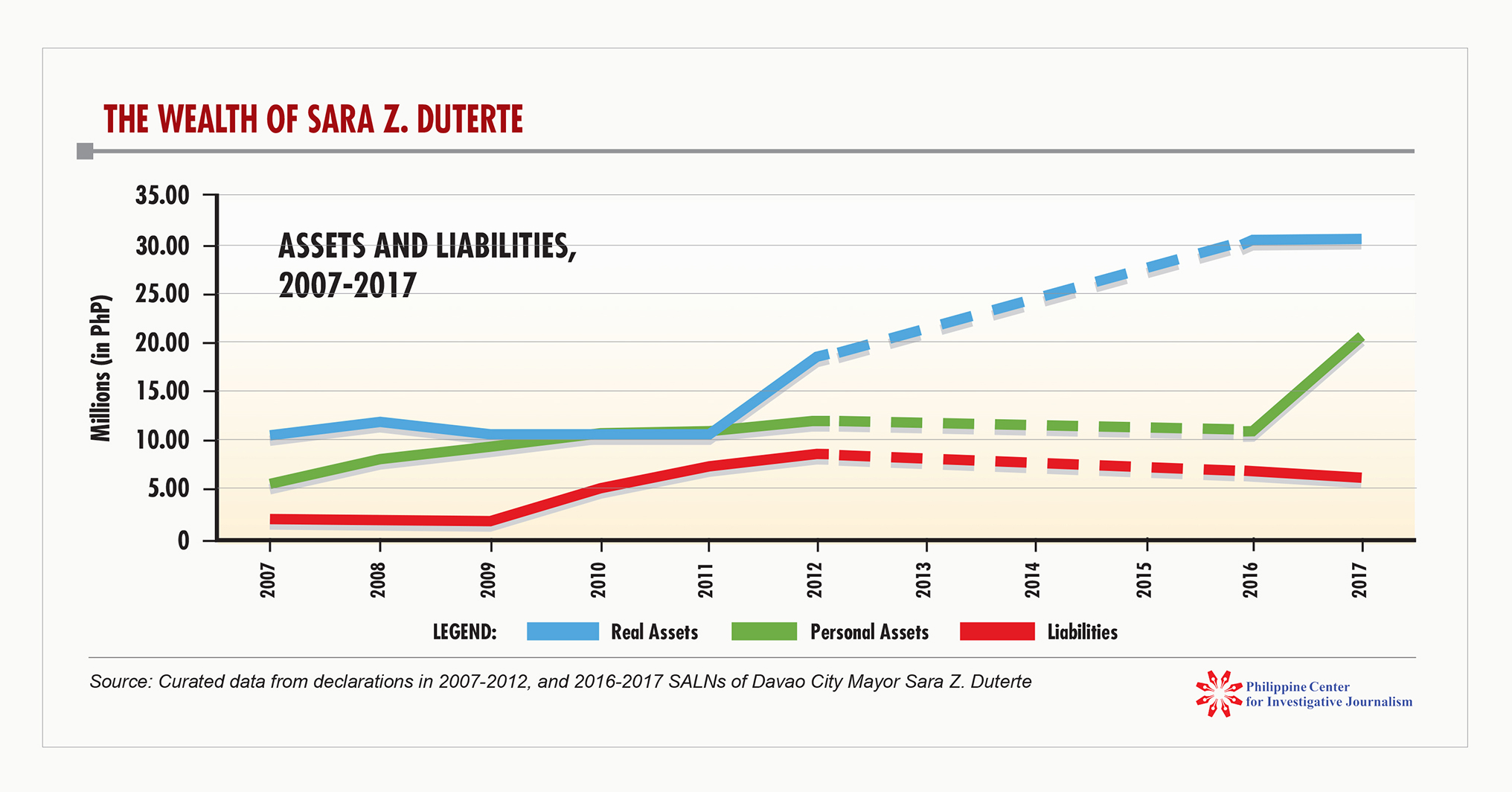
A lot more real assets
By her 2008 SALN, Sara reported owning 11 pieces of real properties worth a total of PhP11.91 million — not by fair market value, but by acquisition cost. These included five pieces of agricultural land (two in Catigan, one in Binugao, and one in Malagos, all in Davao City; and one in Sto. Nino, Babak, Davao del Norte).
The other six properties include four pieces of residential land and a residential land and building worth a total of PhP4.67 million, all in Davao City; and a condominium unit in Quezon City that she said was purchased in 2006 for PhP6.39 million.
Sara’s 2008 SALN also shows that she acquired an agricultural land, two pieces of residential land, and the residential land and building in 1999 with a combined worth of PhP3.76 million. In 1999, she was 21 years old, and still enrolled in college. Sara also said in her 2008 SALN that the condominium unit and an agricultural land were both purchased in 2006, the year she passed the bar; the two pieces of agricultural land in 2007; and two pieces of residential land and another agricultural land in 2008.
Meanwhile, in his 2008 SALN, Paolo reported owning nine pieces of real properties, including three (a residential land and building, a residential land, and an agricultural land) that he said were all “donated” in 2006.
He said that the six other properties, by acquisition cost, were worth a total of PhP10.83 million. Paolo said that in “1999/2005” he bought a residential land and building in Quezon City for PhP1 million; in 2005,one residential land and building in Ecoland, Davao City for PhP5 million; n 2007, two residential land worth PhP750,000 each; and in 2008, an agricultural land worth PhP200,000 and “residential lands with building and improvements” worth PhP3.13 million.
The last property, according to Paolo’s 2008 SALN, was purchased “in an auction sale with DBP (Development Bank of the Philippines).” It was “paid with DBP (Development Bank of the Philippines) on Dec. 3, 2007 but the deed of sale was notarized in 2008.” The property, located in Catalunan Grande Davao City, was covered by three land titles.
(For some reason, however, both Sara and Paolo included the value of their vehicles in computing for the value of their respective real assets in their 2008 SALN. These then would have inflated the total value of the real-estate holdings they declared for that year: PhP15.56 million for Sara and PhP13.74 million for Paolo.)
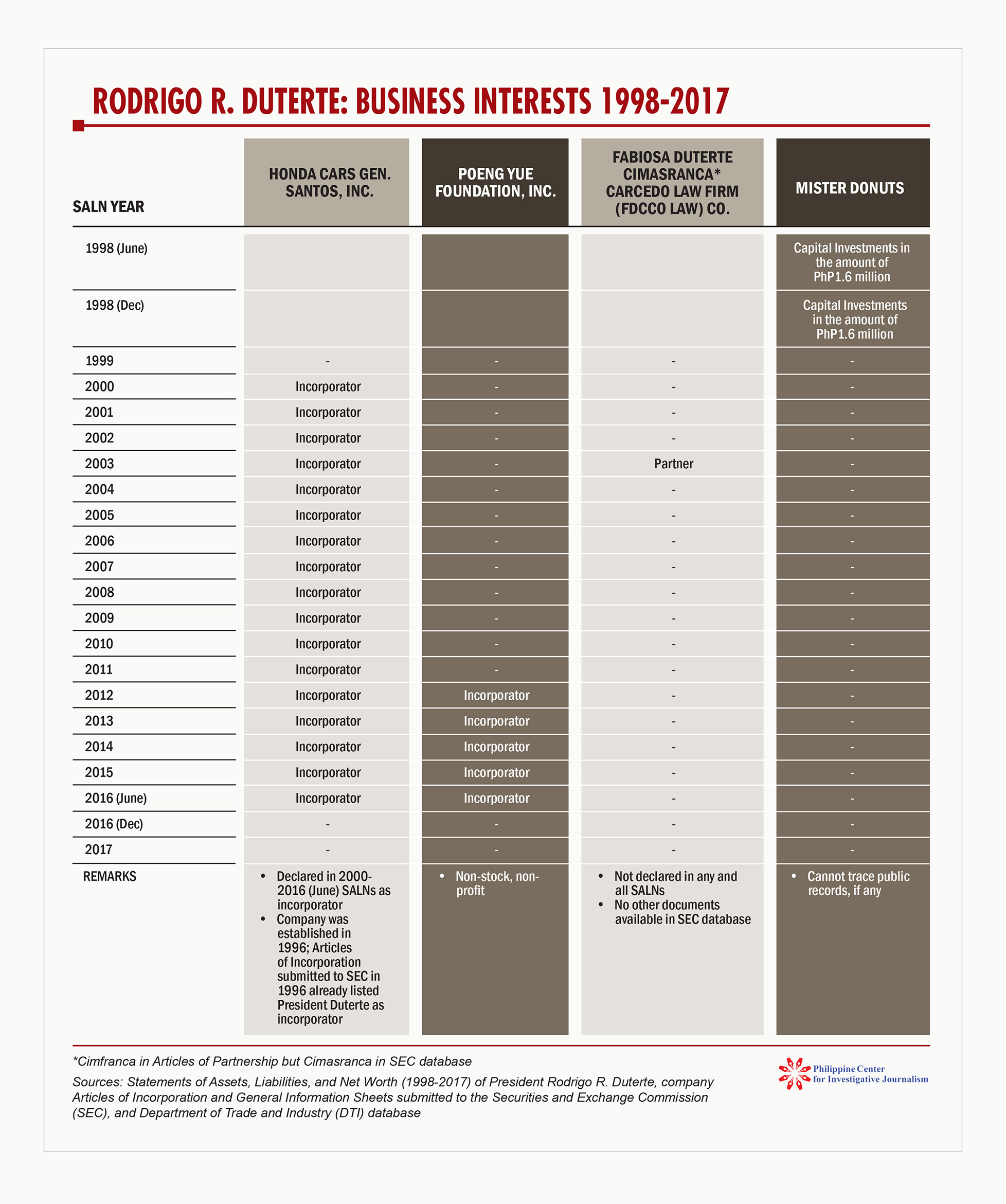
Du30: 3 lots, then more
As for Rodrigo Duterte, in his 2007 SALN, he reported owning only three residential lots that, by fair market value and improvement costs combined, were worth PhP172,000, PhP42,570, and PhP27,000, or PhP241,570 in all. He did not declare the acquisition values of these properties.
In his 2008 SALN, however, Duterte enrolled 10 pieces of real property: seven pieces of residential land, two residential land and building, and an agricultural land. He said nine of the 10 properties were worth a total of PhP2.76 million, by acquisition cost. He put zero value to a residential land and building in Matina, Davao City because it was supposedly “exchanged.” He did not explain what he meant by “exchanged.”
According to Duterte, he acquired four of his 10 real properties in 1996; one in 1997; one in 1999; one in 2005; one in 2007; and two in 2008.
He put three of the 10 properties in the name of Veronica ‘Kitty’ A. Duterte, his child by current partner Cielito ‘Honeylet’ Avanceña. Kitty was born on April 10, 2004. The three properties were acquired by Duterte in 2005, 2007, and 2008. By 2015, he would declare these and two more properties as “purchased through the exclusive funds of the mother, Cielito S. Avanceña.”
Rising, rising
Ten years later in 2017, Duterte, Paolo, and Sara filed SALNs that continue to confuse because of similarly sharp upticks in their wealth. After all, their primary sources of lawful income remained their salaries as public officials and whatever profits from a few corporate entities they own or co-own. Of their firms with financial statements at the SEC, nearly all reported negligible retained earnings year on year.
In their respective SALNs for 2017, President Duterte declared a net worth of PhP28.54 million; Paolo, P27.74 million; and Sara, PhP44.83 million. The numbers show that across the 10-year period from 2007, Rodrigo’s wealth nearly tripled, Paolo’s more than tripled, and Sara’s grew more than six times.

The President’s net worth through the years seems to have risen slowly but steadily, with an average annual increase of PhP1.4 million. Between 2016 and 2017, his net worth saw a modest rise of only four percent. The highest increase in his net worth was in 2008 at PhP5.6 million; in 2001, there was no movement in his net worth at all compared to the previous year.
More cash assets now
President Duterte has maintained liquidity with more personal than real assets. His personal assets – which include his cash on hand and in bank, vehicles, jewelry, investments, and even furniture — reached their largest share of his total assets in 2006 and 2007, at 98 percent, while the biggest share of his total assets that real properties ever got was 38 percent in 2002. In his 2017 SALN, President Duterte declared PhP4.5 million in real assets, PhP25 million in personal assets, and liabilities of almost PhP1 million.
All of the President’s SALNs reflect an increase in his cash on hand and in bank every year except in 1999 and 2001, when his cash assets remained the same as that in 1998 and 2000, respectively. The President’s cash assets grew least in December 1998 at PhP150,000 and most in December 2016 at PhP3.15 million. Both 1998 and 2016 were election years.
The President’s 2017 SALN reflects the biggest cash assets he has ever declared since 1998 at PhP19.4 million. The figure is also the highest among the three Dutertes’ cash assets in 2017.
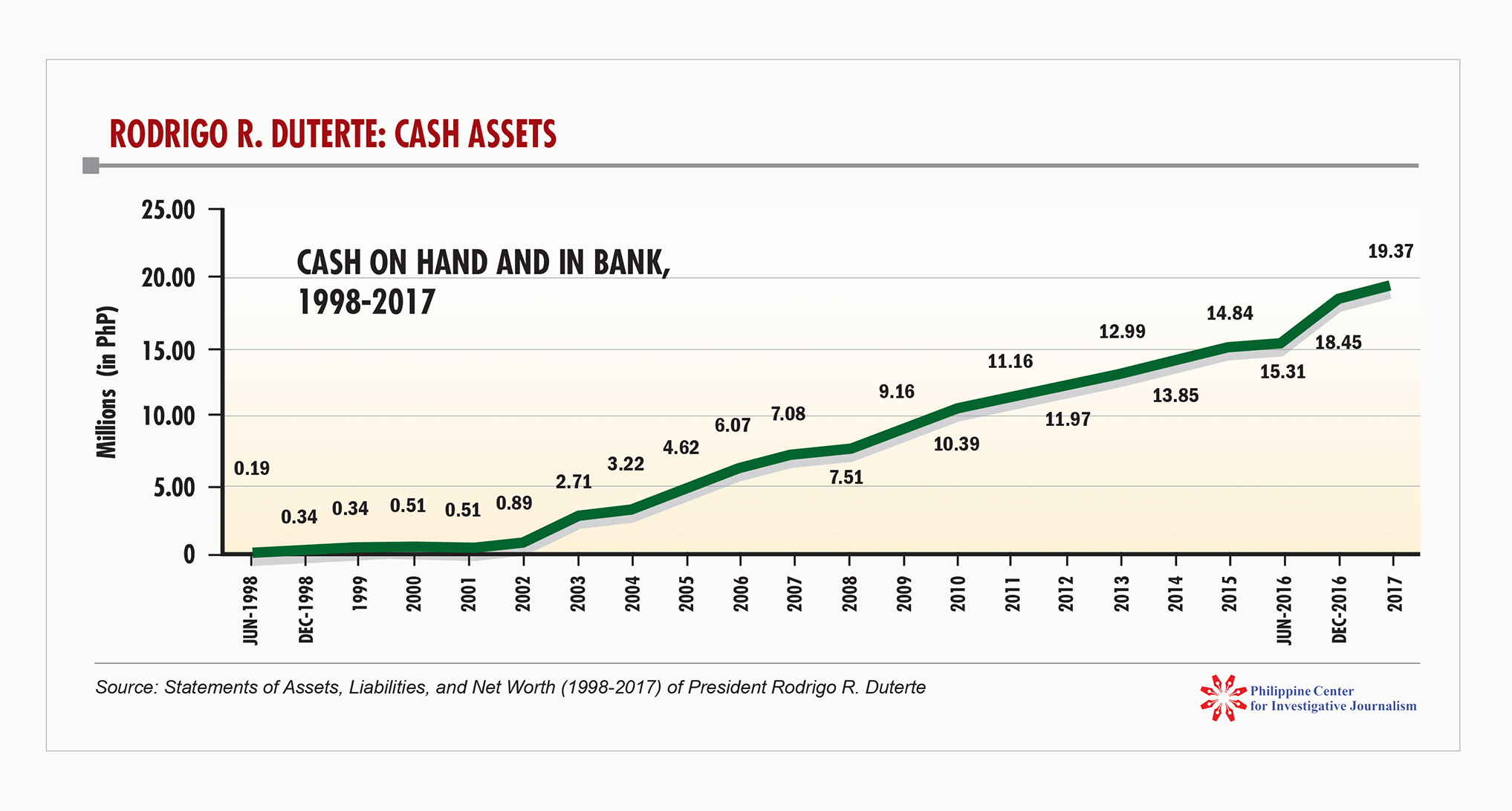
Untouched by elections
Since 1998, President Duterte has run seven times for different posts: once as Congressman for the 1st District of Davao City (1998), four times as Mayor of Davao City (2001, 2004, 2007, and 2013), once as Vice Mayor of the same city (2010), and once as President of the Philippines (2016).
In all these election years, Rodrigo Duterte did not only win the post he ran for; he also managed to leave his cash assets untouched for campaign purposes. In fact, his SALNs during these years would indicate increases in his cash assets, except for the one he filed in 2001, when he ran again as Davao City Mayor.
In the 2013 elections, Rodrigo Duterte ran unopposed for mayor of Davao City. In his campaign-finance documents, he declared a meager PhP85,884 in campaign expenditures, with the bulk of that amount – PhP60,000 – going to meals and drinks at the After Dark Piano Bar. His submitted papers also say that he did not receive any contribution and had zero unpaid obligations.
His 2013 SALN would reflect a PhP723,000 increase in his total net worth from 2012. Broken down, this was due in part to an uptick of PhP1.023 million in his cash assets and PhP50,000 in jewelry. And while the worth of his vehicles slid by PhP500,00, there was also a decrease of PhP150,000 in his liabilities.
In the 2016 Presidential elections, Duterte reported a total of PhP375 million cash and in-kind contributions. He said that he used PhP371.5 million for his campaign, with PhP200,000 coming from his personal funds. That would therefore leave some PhP3.7 million in unspent funds from the contributions he had received.
Duterte’s net worth rose by PhP3.9 million from 2015 to 2016, based on the SALNs he filed during these two years. In fact, much of the increase happened in just six months, between June and December 2016, when his net worth somehow shot up by PhP3.35 million.
His December 2016 SALN reflects an increase of PhP3.6 million in cash assets compared with the corresponding figure in his December 2015 SALN, plus “Other Personal Properties” valued at PhP1 million. Yet even as his liabilities declined by PhP200,000, his investments decreased as well, by PhP900,000, during this period. Then again, 2016 was when he divested from Honda Cars Gen. Santos – his only for-profit private interest appearing in his SALNs since 2000 — which should translate to an increase in his cash assets.
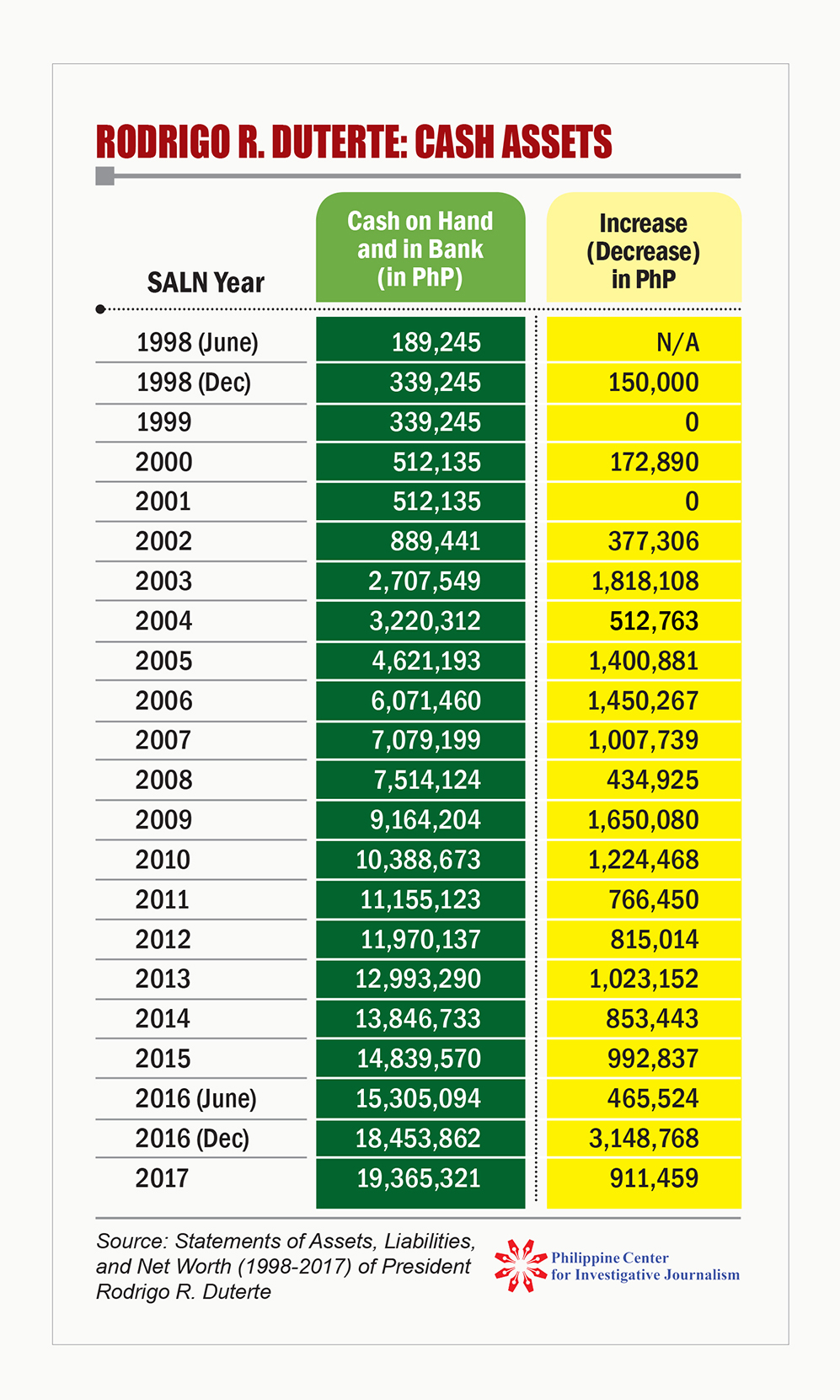
Sudden, sharp rise
In Sara’s case, some unusual situations are apparent, in terms of sudden and sharp rise in her net worth; for certain years, her real assets and personal properties kept growing, despite parallel increases in her liabilities. A year after she was elected vice mayor in 2007, her declared net worth of PhP7.25 million grew to PhP18.49 million in 2008. Curated data using belated declarations of acquisition costs, however, reflect a more modest increase of PhP4.6 million in her net worth from PhP13.88 in 2007.
Yet, her marriage to fellow lawyer Manases R. Carpio in October 2008 may have boosted her net worth only slightly at this time. Sara reported in her 2008 SALN an annual gross salary of PhP340,000, and an annual gross family income of only PhP667,422. By these amounts, it would be hard to explain the significant rise in her net worth, and acquisition of more real assets, from 2007 to 2008 – declared or curated.
She reported an even bigger increase in her net worth as mayor in 2012 of PhP22.12 million, from just PhP14.27 million in 2011. She had in 2012 slightly more liabilities of PhP8.69 million (an additional PhP1.14 million), but also huge upticks in her real assets at PhP18.59 million (an additional PhP7.79 million) and personal assets at PhP12.22 million (an additional PhP1.2 million).
In 2011, Sara had liabilities of PhP7.55 million, real assets of only PhP10.80 million, and personal properties of only PhP11.02 million.

Bigger after break
After a three-year break from public office, Sara reported in her 2016 SALN a net worth of PhP34.9 million, or 58 percent more than her SALN filing in 2012 of PhP22.12 million. A PhP12-million increase in the value of her real assets accounted for the difference.
But the biggest increase in her net worth year-to-year was recorded in her 2017 SALN, filed nearly a year after she returned to work as mayor of Davao City, and her father was elected President. Sara’s net worth in 2017 climbed to PhP44.83 million, or an increase of 28.45 percent from what she had declared the year before. This time, the difference came from a surge in her personal assets, which in 2016 was only PhP11.30 million but ballooned to PhP20.59 million in 2017, or an additional PhP9.29 million.
In her 2017 SALN, Sara reported that her cash on hand/in bank had grown to PhP6.37 million (up from PhP3.75 million in 2016); vehicle/van and vehicle/motorcycles valued at a combined PhP4.1 million (from PhP2.53 million in 2016); and her “Other Personal Properties” valued at PhP3.62 million (from PhP1.18 million in 2015).
She reported, too, that in 2017, her husband Manases had a PhP3.4-million vehicle bought in 2014; PhP1.45-million pick-up bought in 2017; and PhP1.64 million in “Other Personal Properties.” In her 2016 SALN, Sara said that Manases owned only these personal assets: the PhP3.4-million car and PhP500,000 in “Other Personal Properties.”
Her 2017 SALN also shows PhP30.55 million in real assets and liabilities of PhP6.31 million.
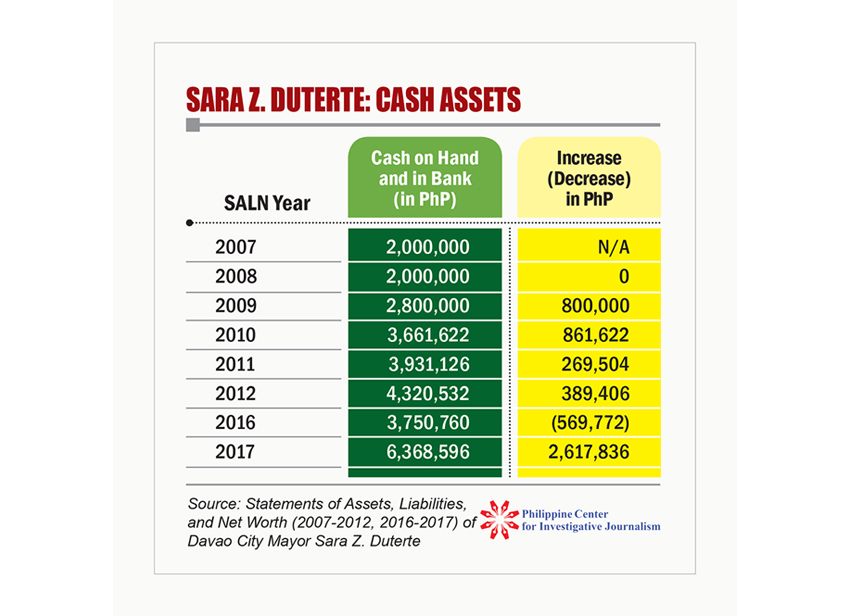
Paolo: Same path
Paolo’s net worth tracked a similar path. The SALN he filed in 2007on his first year in office as barangay captain showed a net worth of PhP8.34 million that rose by 98 percent in 2008 to PhP16.51 million, when he reported the acquisition values of all seven real properties.
In his 2008 SALN, his real assets represented acquisition costs of real properties and vehicles bringing the amount up to PhP13.74 million. Sans the vehicles, he declared his personal assets at PhP4.27 million.
Curated data of his 2007 and 2008 SALNs using acquisition costs of his real properties and reflecting acquisition costs of vehicles under personal properties, Paolo’s 2008 net worth reflects an increase of PhP4.77 million, and increases in real and personal assets computed at PhP3.33 million and PhP342,020, respectively.
In his 2008 SALN, Paolo reported receiving an annual gross salary of only PhP324,624 as barangay captain, and an annual gross family income of PhP951,926.33. These amounts could hardly explain the huge uptick in his net worth from 2007 to 2008.
Paolo would experience his second net-worth upsurge in 2017, although by December of that year he would resign as vice mayor of Davao City.

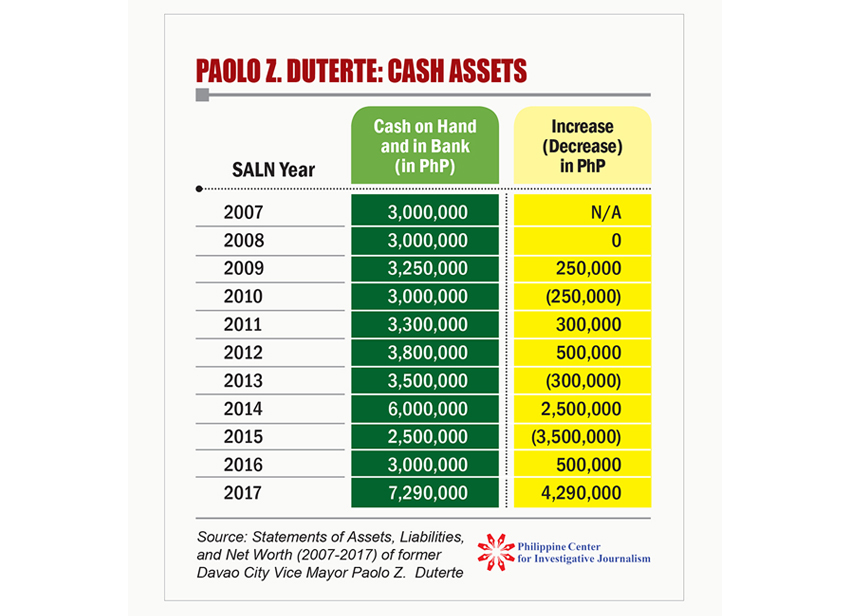
From PhP19.84 million in 2016, Paolo’s net worth rose to PhP27.74 million in 2017, an increase of PhP7.9 million or 39.8 percent.
What accounted for the rise is his personal assets’ growth from only PhP7.82 million in 2016 to PhP13.32 million in 2017. Paolo reported that he had PhP4.3 million more cash on hand (PhP7.29 million from only PhP3 million in 2016); acquired PhP500,000 more jewelry and firearms and PhP110,000 more furniture/furnishings; and invested an additional PhP600,000 in 2017. The increase in his net worth was also boosted by a PhP2-million decrease in his liabilities.
Like his father and kid sister, Paolo had also come out of the 2016 elections with his wallet intact. In fact, from having a declared net worth of PhP18.54 million in 2015, Paolo in 2016 had a net worth of PhP19.84 million. — With infographics by Arnel Rival, PCIJ, 4 April 2018 (reposted by davaotoday.com)
READ PART 1: PCIJ REPORT| The Dutertes: Wealth Reveal & Riddles

